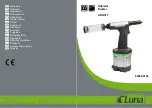
Assembly Instructions - Tips
General Soldering tips
1. ALWAYS KEEP YOUR TIP CLEAN
To ensure the soldering iron can transfer
enough heat from it to your solder/compo-
nent leg you must keep the tip clean and
shiny. A dull tip means the outside layer
of metal has oxidise. This oxidised layer
is a poor transferrer of heat. Because of
this, you will have to hold the tip against
the component for a longer period of time,
which can result in the component failing.
It’s also very frustrating.
To keep your soldering iron tip clean, wipe
it on a wet sponge or wire ball, then apply
some solder to coat it, then wipe it again.
Ideally, you should do this after every com-
ponent. At the very least, do it after every
4 components.
2. CONTACT
When soldering, make sure the tip of your
iron is making contact with both the leg of
the component and the pad on the PCB.
Apply heat to the area, then, within a sec-
ond or two, apply the solder to the point
of contact.
3. HEAT
It’s better to be too hot than too cold. As
mentioned earlier, when the iron tip isn’t hot
enough, you have to hold it on longer. This
allows heat to transfer into the component
and could cause a failure. It is better to set
your soldering iron a little hot so the solder
melts instantly and flows around the leg of
the component with ease. You can start at
around 350oC and adjust from there. Too
hot and the tip will oxidise too quickly,..
4. SOLDER
Leaded solder is much easier to work with,
which makes it easier to learn with. It can
be hard to find in some countries, but can
often be ordered from China. There are po-
tential health risks, but these are very low.
Make sure you have a fan pointing away
from your work area to blow the fumes
away. Work in a well ventilated area.
Thinner is better. Working with a thick wire
of solder can get messy. Use 0.4-0.5mm
solder for more control. You will have to
feed more into the solder joint, but you
have more control when there are other
pins close by that you want to avoid. This
is essential when soldering surface mount
components and Integrated Circuits.
5. SAFETY
350oC is obviously very hot. Stuff catches
fire at this temperature. Skin fries. Please
be careful. Remember to turn it off when
you are finished. This will prevent a poten-
tial house fire and also save your iron tip
from continued oxidation.
6. ANGLE OF ATTACK
When soldering, make sure you position
the board so that it is easy to access the
area you are working on. It is easy to make
a mistake when you are trying to maneuver
your iron into position around some obsta-
cle. You may have to spin the board 180
degrees, or make sure you have snipped
the legs off the previous component. It’s
easy to be impatient so try to plan ahead.
Check the component position using the
images opposite. To help identify the compo-
nents please refer to the table on
page.
LEDs
The LEDs are polarity sensitive, so make sure
the LED is soldered the correct way around.
You will likely destroy the LED if you try and
desolder it, so make sure you get this right.
There are 4 extra LEDs in the kit, just in case.
The negative side of the LED is indicated by a
green mark on the top. There is also a symbol
on the bottom that “points” to the negative
side. This should line up with the “-” symbol
on each of the LED footprints on the PCB.
Be careful you don’t ping these tiny 0805
components across the room, finding them
will be tricky.
To begin, we will first apply some solder to
one of the pads of each of the LED footprints.
This will enable us to solder the first pad of
the LED without needing three hands. If you
are right handed, solder the right pad as you
are looking at the PCB. If you are left handed,
solder the left pad.
We will be holding tweezers in our non-domi-
nant hand (to hold the LED) and the soldering
iron in our dominant hand. Orient the LED in
the tweezers so it will be in the correct orienta-
tion when soldered to the PCB. Bring the LED
towards its footprint on the PCB and get it into
position next to the pre-soldered pad.
When ready, apply heat to the soldered pad
with the soldering iron and simultaneously
bring the LED towards the molten solder.
When the LED is in position and the solder is
covering the LED’s terminal, while still hold-
ing on to it with the tweezers, pull away the
12
Содержание SABER CARD
Страница 1: ...I N S T R U C T I O N M A N U A L SABER CARD v0 92...
Страница 7: ...CIRCUIT Circuit Component Layout D2 R4 U2 D1 R1 R2 C1 C2 R3 U1 D3 D4 D5 D6 D7 D8 D9 D10 D11...
Страница 13: ...ASSEMBLY D2 R4 U2 D1 R1 R2 C1 C2 R3 U1 D3 D4 D5 D6 D7 D8 D9 D10 D11...
Страница 15: ...ASSEMBLY D2 R4 U2 D1 R1 R2 C1 C2 R3 U1 D3 D4 D5 D6 D7 D8 D9 D10 D11...













































